Eustoma: description and varieties, planting and care
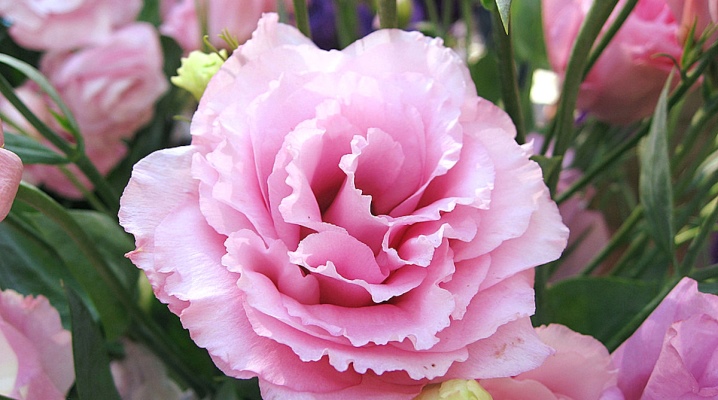
Eustoma is an amazing representative of the world of exotic flora, firmly established in domestic gardens. According to experienced gardeners, the beauty of eustoma during the flowering period more than compensates for all the efforts spent on growing this capricious plant. Consider what such an unusual flower is, how it has a description and varieties, what are the subtleties of planting and care.
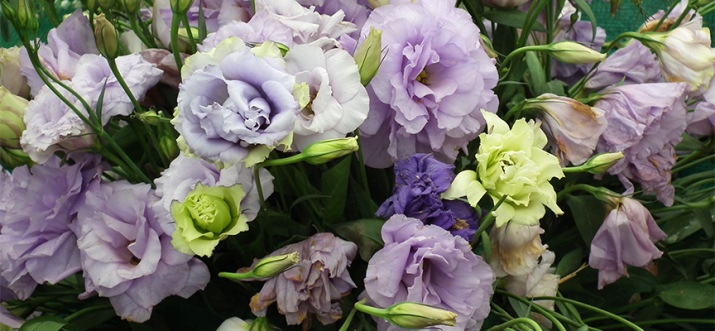
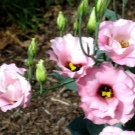


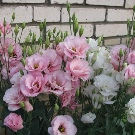

Peculiarities
Eustoma (other common names are lisianthus, gentian, Japanese, French or Irish rose) is a flowering plant usually grown by gardeners as an annual (less often perennial) ornamental crop. Among the indisputable advantages of this plant, landscape designers note very showy, long lasting and almost continuous flowering.
The genus Eustoma (the outdated name of the genus is Lisianthus) includes annual and perennial herbaceous plants of the Gentian family. In the wild, they are found in Mexico, southern North America and northern South America. And also to the area of their growth include the Isthmus of Panama and a number of islands in the Caribbean Sea.
Representatives of the genus are herbaceous medium-sized plants, the height of which can vary from 40 to 60 centimeters. The height of individual representatives of this genus can be 90-100 centimeters or more. Plants have many erect, graceful stems, densely covered with ovoid or lanceolate sessile leaves. The color of stems and leaves varies from pale green to silvery emerald.

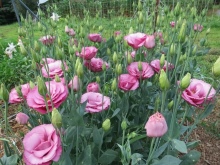
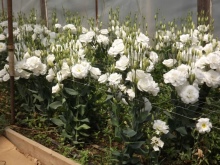
Eustoma flowers can be simple, semi-double or double, similar in appearance to bells, poppies, roses or daylilies. The average size of flowers across is 5-8 centimeters. The shape and color of lisianthus flowers usually depend on the species / varietal characteristics of the plant. The color palette includes creamy white, peach pink, lavender lilac, violet lilac, golden beige and many other tones. The color of flowers can be either monochromatic or variegated.
During the flowering period, lisianthuses look very impressive. This is facilitated by their tendency to massive formation of flower ovaries. So, in some varieties, 1 stem can have up to 20-25 flowers and flower ovaries at the same time. Visually, blooming eustomas resemble varietal rose bushes with the only difference that there are no thorns on their stems.
Lisianthus bloom usually lasts from late May to October. Some varieties are able to bloom profusely before the onset of persistent cold weather.
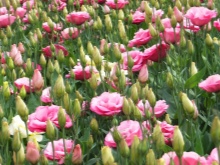


Types and varieties
In ornamental gardening, both natural types of eustomas and their cultivated forms and varieties have become widespread. To date, breeders have bred many varietal lisianthus with very large double and semi-double flowers of various colors.
- Eustoma large-flowered - one of the natural species, the natural habitat of which is the south of the United States. In the wild, this species of lisianthus usually grows in floodplains and lowlands of rivers. Plants can reach 35-95 centimeters in height. Stems are thin, strongly branching, pale green with a silvery gray tint.
Leaves are ovate, with a rounded or pointed apex. The flowers are large, reaching 7 centimeters in diameter, bell-shaped. The color of the flowers is purple-violet or lilac-blue.
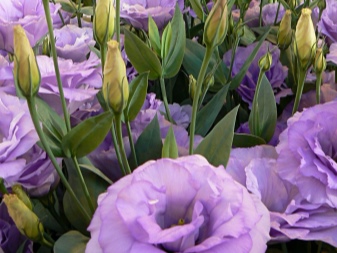
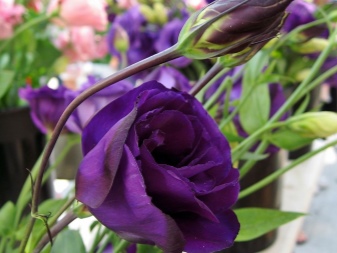
- Eustoma small Is another natural Lisianthus species found in the southern United States and Mexico. Another common name for plants is the seaside gentian. In the wild, this species is found mainly in humid places - in swamps and the shores of fresh and salt water bodies. Plants have numerous erect stems, densely covered with small gray-green leaves.
Flowering continues throughout almost the entire growing season. The flowers are bell-shaped, large, lilac-purple in color. The heart of the flowers is golden yellow.
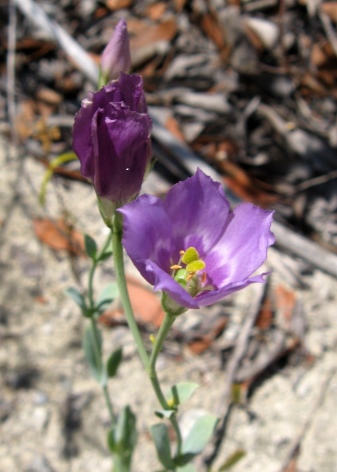
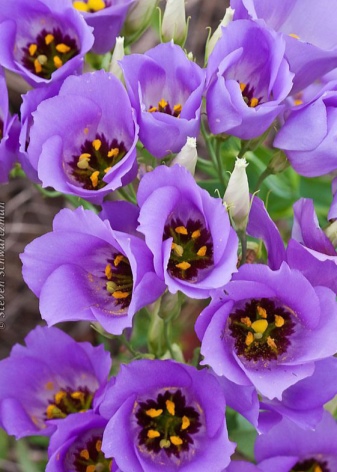
- Champagne - the original variety of large-flowered eustoma from the Magic series, bred by Japanese breeders. The average plant height is 75 centimeters. Flowers are densely double, with strongly corrugated edges, reaching 8 cm in diameter. The color of the flowers is pale pink, with a slight pistachio shade on the periphery of the petals. Recommended for cutting.

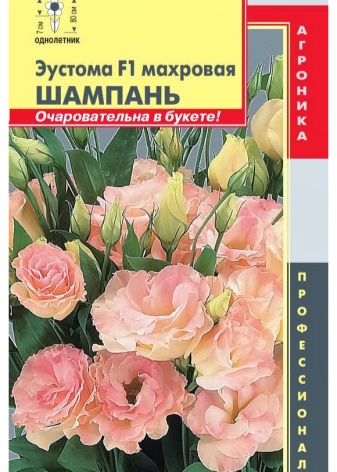
- "Carmen" - a series of varieties of low-growing eustomas recommended for cultivation in greenhouses. Plant height is about 20 cm. Bushes are compact, multi-stemmed. Leaves are ovoid, with a pointed apex, light green. The series includes a number of varieties of different colors: "Rose" - with pale pink, "Lilac" - with lilac-pink, "Blue Rome" - with white and blue flowers.
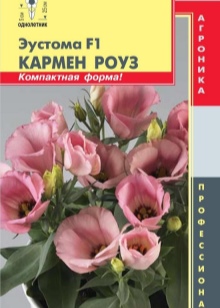
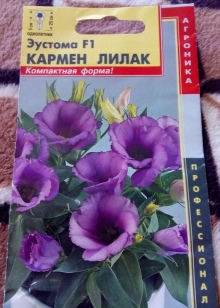
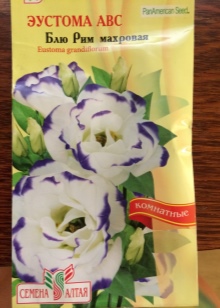
- "Pink" - a very effective variety of tall, large-flowered eustomas from the Echo series. In height, the bushes of plants can reach 85-95 centimeters. The flowers are large, double, deep pink in color.
The variety is recommended for cutting, as well as for creating multi-tiered flower beds and high beds.

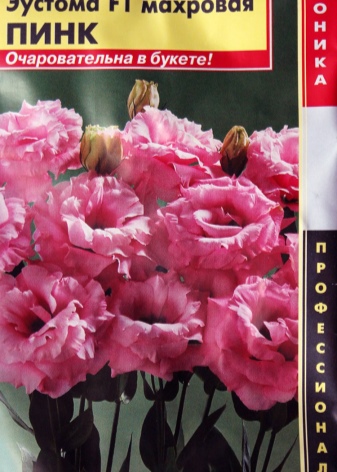
The subtleties of growing at home
Eustomas are considered quite pretentious plants that require the most comfortable living conditions and competent care. The exotic origin of these beauties largely determines the specificity of their requirements for illumination, temperature and humidity conditions, and soil composition.
Lighting
Eustomas prefer moderately bright, diffused sunlight. For this reason, plant pots are recommended to be placed on windowsills located in the southeast, east, southwest or west of the house. On very hot days, plants should be protected from the scorching sun.
It is important to remember that direct sunlight is detrimental to these delicate representatives of the ornamental flora.
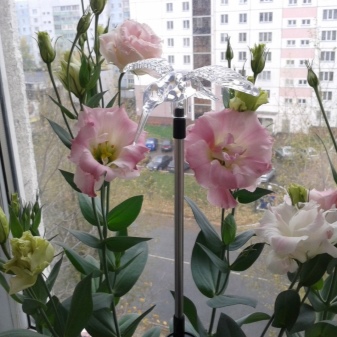
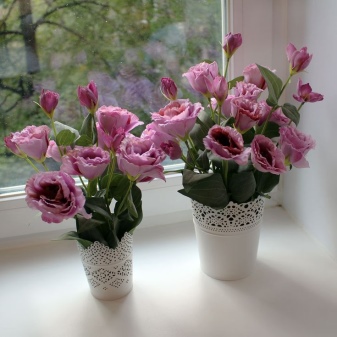
Temperature and humidity
In summer, indoor eustomas will feel comfortable at an indoor air temperature of + 20-23 ° C. With the onset of autumn, it is recommended to lower the temperature to + 18 ° C. In winter, when the plants are dormant, it is preferable to maintain the air temperature in the room at + 10-15 ° C.
To maintain optimal air humidity, indoor eustomas should be watered regularly, preventing the soil from drying out in the pot. These plants do not need spraying or additional humidification of the air.
In very hot weather, it is allowed to place a wide container filled with water next to the plants.



The soil
For growing lisianthus at home, it is recommended to use soil mixtures with a neutral or slightly alkaline reaction. Experienced gardeners often use store-bought soil mixtures intended for uzambar violets to grow indoor eustomas. It is also allowed to use soil mixtures prepared from peat soil, garden soil and clean river sand (1: 1: 1).
Before placing in the planting container, it is recommended to disinfect the prepared soil mixture with a hot solution of potassium permanganate.
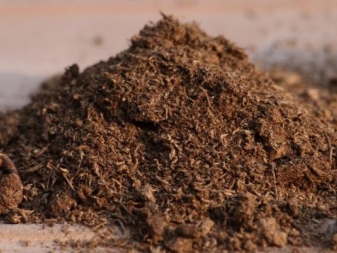

Care
The main care for lisianthus grown at home is regular watering, periodic feeding and the timely removal of dried inflorescences. Watering indoor lisianthuses should be frequent, but in moderation. In summer, the frequency of watering is increased, in winter, it is reduced.
Only soft settled water is used for irrigation. Watering delicate eustomas with cold hard water is strictly not allowed. During watering, a stream of water is directed to the base of the bush.
It is important to ensure that no drops fall on the leaves, stems and flowers of the plant. Watering eustoma is best in the morning or evening.

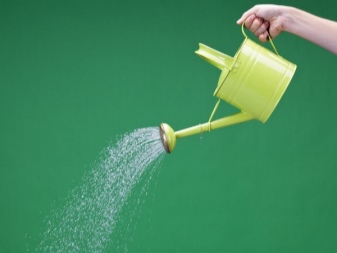
Regular feeding will ensure lush and long-lasting flowering of indoor eustomas. It is recommended to use complex fertilizers based on potassium and phosphorus as basic dressings. The recommended frequency of feeding is once every 2-3 weeks.
The main stages of plant nutrition:
- phase of active growth, requiring the introduction of nitrogenous fertilizers;
- budding phase (potassium-phosphorus fertilizers);
- the phase of the beginning of flowering (potash fertilizers).
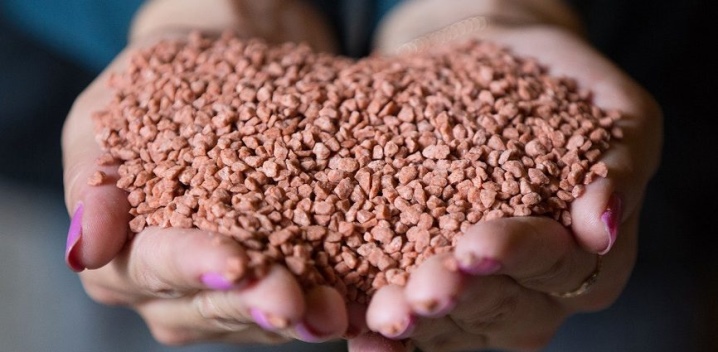
How to plant in open ground?
Eustoma is most often grown outdoors as an annual crop. Before planting young plants (seedlings) in your country house, you must determine the most suitable place for them in advance. The best choice for Lisianthus is a slightly shaded corner in the garden, protected from direct sunlight, drafts and wind. The soil at the planting site should be moisture and air permeable, fertile, moderately moist.
Young plants are planted in May, when the probability of night frosts is reduced to a minimum. In regions with a harsh climate (in the Urals, in Siberia), lisianthus planting in open ground is usually started at the end of May or in June. Planting seedlings is carried out only in well-warmed soil.
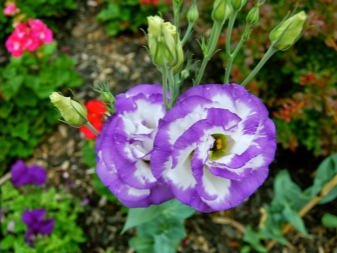

Step-by-step instructions for planting young eustoma bushes in the garden include the following:
- arrangement of holes at the landing site;
- watering the holes with warm, settled water;
- planting seedlings in holes by transshipment (together with a lump of earth on the roots);
- filling of voids in holes with seedlings with moist fertile soil.
When arranging the holes, it is necessary to ensure that their diameter corresponds to the size of the root ball of the seedlings. It is necessary to plant plants at a distance of 20-25 cm from each other. After planting the seedlings, the ground in the trunk circle is lightly tamped with palms and sprinkled with mulch. Next to very tall plants, a support is erected from thin wooden planks.

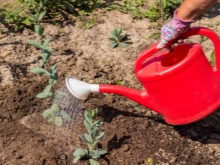
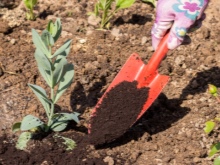
How to take care of it properly?
Lisianthuses, being quite whimsical plants, require increased attention. Failure to follow the recommendations for caring for these capricious garden dwellers can negatively affect both the quality of flowering and the state of plant health.
Watering
Eustomas grown outdoors need moderate but regular watering. The frequency of watering is determined based on weather and climatic conditions. So, in regions with a cool climate and cool / cloudy summer, the frequency of watering can be no more than 2-3 times a month. In hot and arid southern regions, the frequency of irrigation can increase to 5-6 or more times a month. It is recommended to water lisianthuses in the morning using settled water.
A moisture deficit in the soil for these plants is as harmful as an excess, therefore, in no case should you pour lisianthus with water.
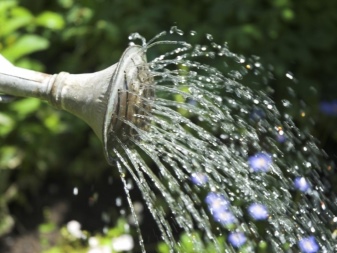
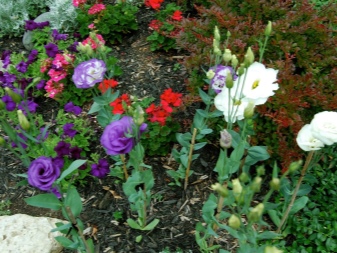
Fertilizer
2 weeks after planting in open ground, it is allowed to feed the plants with nitrogen-containing fertilizer. This procedure will promote the active growth of shoots, leaves and roots. During the budding period, all flower crops need fertilizing containing potassium and phosphorus. At this stage, you can use ready-made complex formulations, for example, "Kemira" or "Kemira Lux".
Another top dressing is provided at the beginning of flowering plants. With the appearance of the first flowers, the bushes are recommended to be fed again with phosphorus-potassium fertilizers. Experienced flower growers advise at this stage to apply fertilizers "Plantafol Budding", "Kemira Lux". These preparations stimulate the active formation of buds and contribute to a brighter color of flowers.
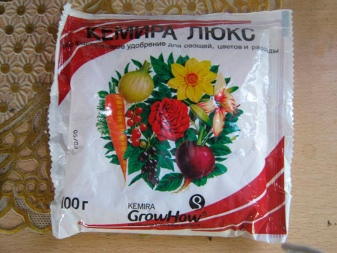
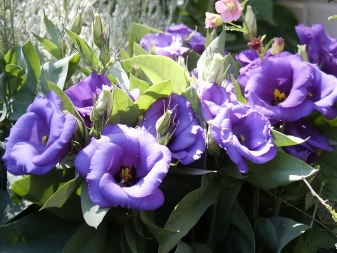
Bloom
The main secrets of the exuberant and lush flowering of eustomas are the regular application of fertilizers and the timely removal of dried inflorescences. Observations show that these simple manipulations can not only enhance, but also significantly prolong the flowering of Lisianthus. It is worth noting that not all budding gardeners know what to do with plants after flowering.
At this stage the faded bush must be carefully dug up and transplanted together with a lump of earth on the roots into a separate container... Further, the shoots of the plant should be cut so that 2-3 internodes remain on them. In this state, the plant can be sent for wintering in a cool room, or it can be placed on the lightest windowsill in the house, stimulating the development of new shoots and flowering arrows.
With sufficient lighting and timely watering, a pruned bush is able to quickly build up a green mass and bloom again.

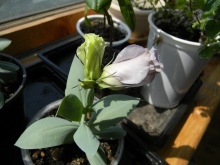

Seed collection
Eustoma seeds are harvested from healthy varietal plants. Usually this procedure is carried out in the second half of September, in dry and calm weather. In the course of work, dried light brown or gray-brown seed pods are carefully separated from the plants, which serve as a container for many very small dark seeds, visually similar to lobelia seeds.
With proper storage, a new generation of eustomas can be grown from the harvested seeds with the same varietal characteristics as those of the mother plants.
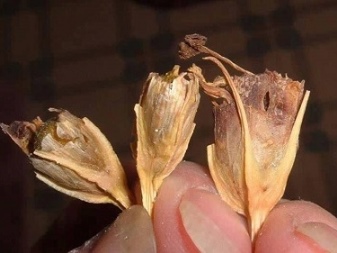
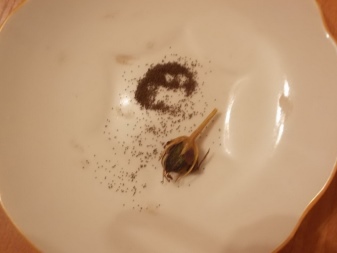
Wintering
Eustoma, grown on the site as a perennial crop, winters well at home. To do this, the faded plant is transplanted into a separate pot in the fall, its stems are cut to a height of 2-3 internodes from the surface of the earth..
After that, the container with the plant is placed in a cool room with a constant air temperature at + 12-13 ° C. Water the bush as needed. Under such conditions, the dormant eustoma is kept until spring.
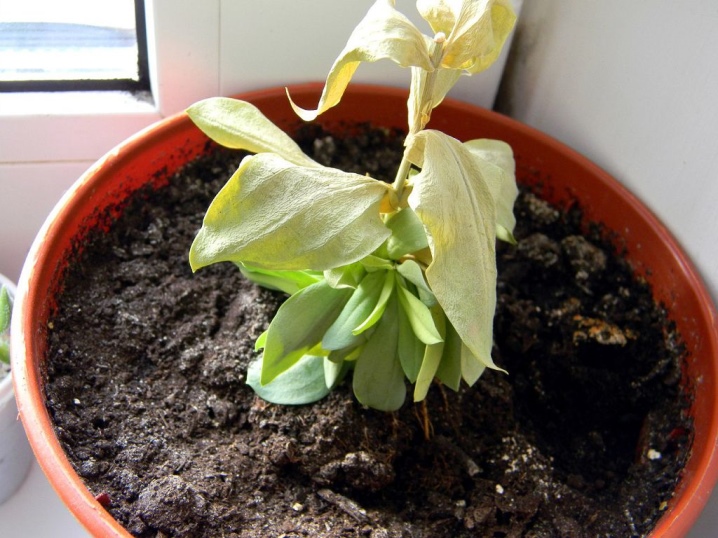
Reproduction methods
For the reproduction of eustoma, gardeners most often use seeds, less often cuttings. The seed method of propagation of these flowering plants is considered the most effective.
Seeds
To obtain lisianthus seedlings from seeds, it is recommended to sow the seeds in February or March. Sowing of seeds is carried out in containers with a very loose soil mixture, consisting of peat soil and fragments of the bark of deciduous trees (1: 1). Suitable for sowing seeds and ready-made store substrate for growing seedlings.
Before sowing, the surface of the substrate is leveled and well moistened. Then seeds are spread on the moistened ground (seed material is recommended to be purchased in a coated form) at a distance of 2-3 centimeters from each other. The decomposed seeds are lightly pressed to the ground with a fingertip, after which the crops are sprayed with warm water from a spray bottle. Do not sprinkle the seeds with sand or earth.
Next, the container with crops is tightened with a transparent film, in which several small holes are made for better air circulation. Before the emergence of shoots, carefully monitor the level of moisture in the ground and air in an impromptu "greenhouse". The waiting time for the first shoots is 2-3 weeks. Before the emergence of seedlings, the container with crops must be periodically ventilated, occasionally spraying the substrate.
In the second half of March, the container with seedlings should be sent to a place with soft diffused light, protected from drafts. The air temperature in the room should be + 20-22 ° С.Strengthened seedlings are allowed to dive in 6-8 weeks, when 2-3 pairs of true leaves are formed. It is strongly discouraged to postpone the pick until a later date.

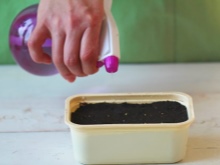

By cuttings
Some tall varieties of Lisianthus can be propagated by apical or intermediate cuttings. This procedure is usually carried out during the period when the plants are in the phase of active growth and budding. To obtain planting material, the strongest multi-stem eustoma bush is selected, from which a healthy, well-developed shoot is separated. This shoot is cut into pieces so that there are about 4-5 internodes on each cuttings.
Further, the lower leaves on the cuttings obtained are removed, and the upper ones are cut in half. Then the lower cut of each cutting is powdered with a root stimulator ("Kornevin") and placed in a glass of water for 6-8 hours. Root cuttings of lisianthus in plain water. If all the recommendations are followed, the first roots in cuttings appear after 2-3 weeks. After that, the rooted planting material can be planted in separate cups with loose soil.
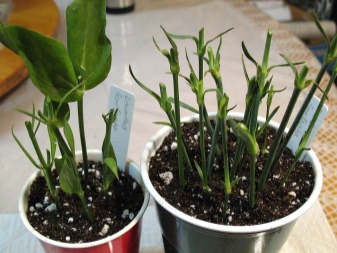
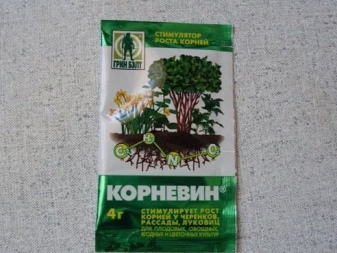
Diseases and pests
Increased air humidity, waterlogging of the soil, irrigation irregularities - the main reasons for the development of gray rot and powdery mildew in Lisianthus... The development of rot is indicated by the appearance of dirty gray spots on the leaves and stems of the plant. Light yellow or gray-whitish spots on the leaves indicate the defeat of Lisianthus with powdery mildew. The fight against both diseases involves the treatment of plants with fungicidal agents (Fundazol, Topaz).
If the rules for growing eustoma in a greenhouse or greenhouse are violated, the plant can be attacked by a whitefly. This tiny parasite feeds on plant juices, as a result of which they quickly weaken, dry and die. Effective drugs against this pest are "Aktara", "Confidor Extra", "Fitoverm".
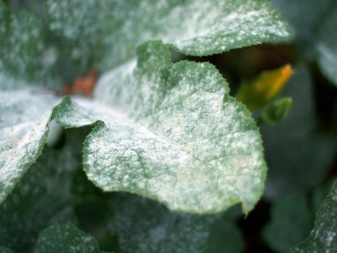
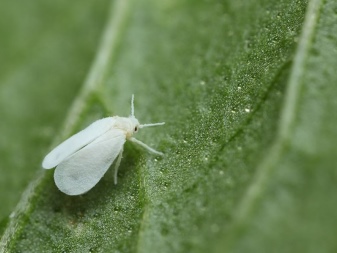
Fungal mosquitoes, whose larvae damage the roots of plants, pose a serious threat to Lisianthus. It is usually not difficult to find this pest, since a flock of small, dark colored flying insects can almost always be seen next to the affected plant. The fight against mushroom mosquitoes and their larvae involves the treatment of affected plants and soil with preparations "Aktellik", "Fitoverm", "Decis".
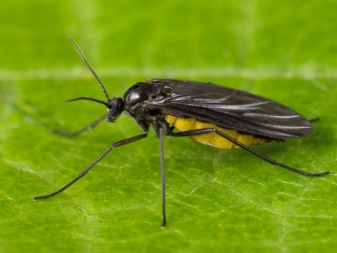
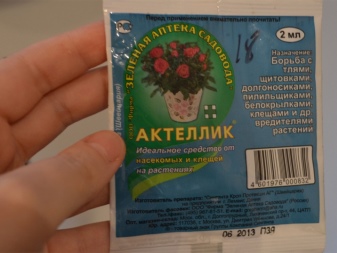
What colors does it match?
Graceful eustomas are able to successfully fit into the atmosphere of any personal plot. With their help, you can easily create incredibly beautiful flower beds, multi-tiered mixborders, and interesting container compositions. Ornamental shrubs, grasses, cereals and conifers are perfectly combined with these flowering plants.
So, airy miscanthus, emerald thuja or juniper can be an excellent background for flowering lisianthus. It is not difficult to create an original decoration for the garden using a mix of several varieties of high or medium-sized Lisianthus. Arbitrarily mixing eustoma with flowers of red, pink, golden yellow or orange in one composition, you can get a rather bold, but very effective result.
It is noteworthy that such a flower bed of eustomas will delight its owner with cheerful colors until late autumn.
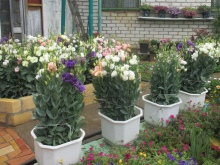
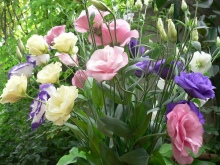

When choosing suitable neighbors for eustoma, you should pay attention to decorative crops with monochromatic, but not too bright flowers. So, it will be quite interesting in group plantings to look eustoma together with garden daisies (cornflower), neutral yarrow, fragile gypsophila, graceful chrysanthemums.
The neighborhood of flowering lisianthuses with white, pink and purple mallows, blue or blue lobelia, juicy orange marigolds will also become organic. A modest low hosta with monochromatic dark emerald leaves and a lacy decorative fern will set off the beauty of eustoma.
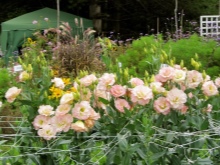
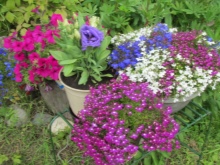
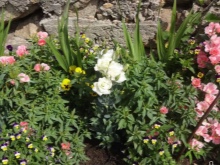
For more on growing eustoma, see the next video.






































































































The comment was sent successfully.